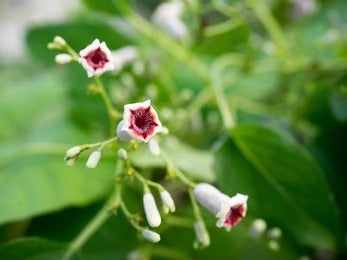The climber plant known as Gandha Prasarini (Paederia foetida) has ovate to lanceolate leaves. The leaves of the Gandha Prasarini are about 5 cm long and 2.5 cm wide. The leaves have lengthy petioles and are membranous as well. Purple or violet Gandha Prasarini flowers are found on scorpiod cymes. The roots of Gandha Prasarini are compressed on both sides, cylindrical or sub-cylindrical, and their exterior surface is covered in root scars. The fruits are ellipsoid, compressed, and either red or black in hue. It has a fibrous texture, a brownish appearance, a light brown inside, and a bitter flavor.
What is Gandha Prasarini
A key herb used in Ayurvedic medicine is called Gandha Prasarini (Paederia foetida). Gandha Prasarini's Sanskrit meaning is "it spreads foul odor" It is a distinguishing quality of this herb. Prasarini means spreading, and Gandha denotes stench.
It's made up of a bunch of different ingredients, like essential oils (methyl mercaptan, Linalool), Iridoid glucosides (Asperuloside, paederoside and scandoside, riterpenoids and saponins Ursolic acid, epifriedelinol, campesterol, sitosterol, stigmasterol, and friedelin), Alkaloids, fatty acids (capric, lauric, myristic, arachidic and palmitic acids), Quinones (Embelin), Valine, Tyrosine, Histidine carotene, and Vitamin C.
It has a number of medicinal qualities including anti-inflammatory, antioxidant, bacterial, helminthic, and hypoglycemic. It is used to cure a variety of illnesses such as rheumatism, paralysis, abscesses, gout, diarrhea, dysentery, infertility, colic, and flatulence due to its various qualities.
Its various components are employed in a variety of Ayurvedic preparations. Its roots are used as an emetic and to treat spleen inflammation, chest pain, and herpes infection. Its leaves are used to treat herpes infection.
Classification
Kingdom: Plantae
Order: Gentianales
Family: Rubiaceae
Genus: Paederia
Species: Foetida
Habitat
From Dehradun eastward, up to an elevation of 1800 m above sea level, it can be found in the Himalayas. In addition, it is present in Assam, Bengal, Orissa, and Bihar.
Names
Botanical Name - Paederia foetida
Hindi Name – Gandhaprasarani or Pasaran
English Name - Chinese flower
Sanskrit Name - Prasarini, Gandhpatra
Telugu Name – Takkeda, Savirel
Bengali Name – Gandhabhaduliya, Gandhabhadule, Gandal
Marathi Name – Hiran- vel, Hiranvel, Haranvel
Gujarati Name – Gandhana, Prasarini
Tamil Name – Pinarisangai, Mudiyar, Kundal
Assamese Name – Paduri lota or Bhedai lota
Kannada Name - Hesarani, Prasarini bail
Malayalam Name - Tala nili
Punjabi Name - Prasarini
Oriya Name - Suprasara
Ayurvedic Properties
|
Particular |
Hindi / Sanskrit |
English |
|
Rasa (Taste) |
Tikta |
Bitter |
|
Guna (Physical Property) |
Guru, Sara |
Heavy, Flowing |
|
Virya (Potency) |
Ushna |
Hot |
|
Vipaka (Post-Digestive Taste) |
Katu |
Pungent |
Effects On Doshas
It manages Kapha and Vata doshas.
Practical Uses & Benefits
- It is effective in treating edema and any other inflammatory disorders since it possesses anti-inflammatory properties.
- It is effective in treating joint issues like gout, arthritis, and joint discomfort.
- It helps to balance the vata and kapha doshas in the body and the diseases that are linked to them.
- It also enhances the quality of the semen and has aphrodisiac properties. It also possesses anthelmintic properties.
- It provides relief from bloating and abdominal pain.
- It boosts immunity and gives the body resistance to several infections.
- Also, the central nervous system is stimulated by it.
- Fever can also be treated with it.
- It has diuretic qualities as well.
- Fruits of this plant are used to treat toothaches.
- It possesses antispasmodic and hepatoprotective properties.
- Its oil is quite helpful for a variety of joint diseases.
- This herb is a common essential component in massage oils used to balance Vata. This herb reduces pain, inflammation, and stiffness when used topically.
Part Used
Root, Leaf
Dosage
Infusion: 12-24 ml
Fresh Juice: 10-20 ml
Decoction: 50-100ml
Powder: 2-4 g

